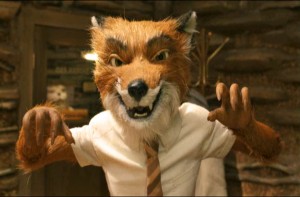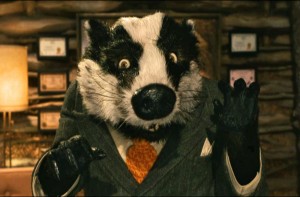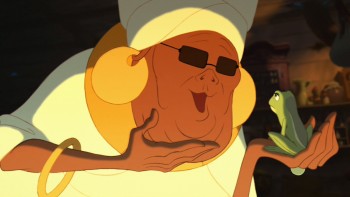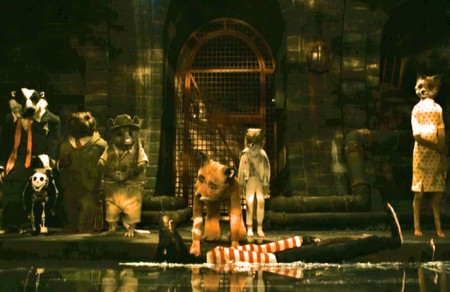Commentary &Disney 30 Dec 2009 08:49 am
Another look at 2 features
- I’ve seen a couple of this year’s features another time this past week and have had some more thoughts about them.
 I’ve now seen The Fantastic Mr. Fox a third time. Twice in theaters and once on DVD. All three times it was every bit as entertaining for me as it was on the first viewing. I was more impressed with the levels of depth cleverly written within the film.
I’ve now seen The Fantastic Mr. Fox a third time. Twice in theaters and once on DVD. All three times it was every bit as entertaining for me as it was on the first viewing. I was more impressed with the levels of depth cleverly written within the film.
There are the same father/son complications of every Wes Anderson film, however more interesting to me was the thought on the nature of the film’s creatures.
 The Royal Tenanbaums treat each other as if they are Royal. The Foxes are wild animals; they know it and allow their true nature to emerge. Look at every time they eat, attacking wildly and voraciously.
The Royal Tenanbaums treat each other as if they are Royal. The Foxes are wild animals; they know it and allow their true nature to emerge. Look at every time they eat, attacking wildly and voraciously.
The animals in costume are little more than their natural selves: a fox is a fox and it’s unable to resist its natural, wild tendencies. A badger is a badger and tempers will rise when mixing with a fox. Though he’s a friend and lawyer to the fox, the two spit and spat whenever they meet.
This is not the same lax world as many past cartoon creations. Bugs Bunny was rarely, if ever, a bunny. He was more a foil for Elmer Fudd (or in some cases Daffy Duck, who started life as a duck but became something other.) Mickey Mouse could mix with Donald Duck, or Goofy, and all could just act as humans do with little regard for their off-sized proportions or animal natures. (Admittedly, Pluto always stayed a dog despite the fact that Goofy was also a dog, and Mickey Mouse was his owner and larger than the dog.)
This is the cartoon world, and there’s nothing wrong with it. It’s just that Mr. Fox takes it into a different direction – thanks to the spirit of Raold Dahl, which Wes Anderson followed closely. And in doing that Anderson asks what is our true nature? What is wild within us when we, as adults, seem to have learned to temper those base instincts.
The animation of some of the Beatrix Potter stories have followed the animal natures of the characters, but adaptations of The Wind in the Willows have not followed the book’s logic. In the book the animals ARE pointedly animals – despite wearing clothes and acting more human-like.
To me, the film is witty, charming and wholly satisfying. Even the stodgy, stiff animation is part of the appeal. There’s a quaint and homespun feeling to the characters in this old-time, hand-made animation. Sitting next to me in the theater, this last time, was a mother (about 30) with her son (about 10). She was quiet during the film, he was certainly enjoying it. When the film ended, the boy asked his mother excitedly, “Didn’t you just love the farmer?” The mother hesitated for a long time, then said, “I guess so.” She seemed not to enjoy the film while her son gushed over it all the way out of the theater. Not all films are for everyone.
The Princess and the Frog I saw for a second time on DVD. Actually, I could only make it through about 2/3 of the film on the second viewing. Its flaws were larger for me on the small screen and at second viewing.
The largest hurdle for me on the first viewing was the story, and it remained the complete shambles it was the second time out. It’s an embarrassment to me that this film came out of the Disney studio with no one noticing how poor the story and the storytelling is.
 The only joy was in seeing animation so rich – not always good but always rich and professional. It’s been a while since we’ve had even that.
The only joy was in seeing animation so rich – not always good but always rich and professional. It’s been a while since we’ve had even that.
The movement and character development, in this film, was often more Warner Bros than Disney – wilder, broader and hard-edged. The last few Disney 2D features seemed to be making a split. Half the animation seemed very Don Bluth while the other half was more WB. This, of course, was just my perception. Only a couple of animators seemed distinctly out of the Disney mold – Andreas Deja and Glen Keane, for two.
I like Andreas Deja‘s animation of the voodoo queen, Mama Odie, introduced to us in the last third of the film. (Really! Was there no way to introduce this character earlier in the film?! I can think of half a dozen ways to do it, and the film could have used more of her.) Unfortunately, she’s on the screen too short a time to separate her from Mad Madam Mim or The Rescuers’ Madame Medusa.
It’s interesting that the film includes the death of a bug (a bug also introduced in the last third of the film), and that’s supposed to make us feel something. Of course, it becomes a star (there must be lots of stars – meaning dead bugs – that we don’t see up there) as the directors try pointlessly to pull the heartstrings. More disheartening than heartfelt.
In Mr. Fox, when the villainous rat dies, no such poor attempt is made to manipulate our emotions. Anderson didn’t sentimentalize the death. “Just another dead rat in the garbage pail behind the Chinese restaurant.”


on 30 Dec 2009 at 11:04 am 1.Mark Mayerson said …
I’ve only seen each of these films once, but I agree that the fox is better than the frog. It proves that a filmmaker with a point of view, regardless of animation experience, is going to produce a superior film to one made by people who don’t really have anything to say.
That should give us all pause. When experienced animation writers and directors can’t compete against an animation neophyte director, what is our value? Perhaps we’re going to devolve into what the visual effects industry is: servants to someone else’s vision.
on 30 Dec 2009 at 11:14 am 2.Michael said …
Exactly right, Mark. That’s pretty much the way I see the animation industry today. Too many defending the Zemeckis junk bacause there are “animators” employed and we wouldn’t want them to lose their jobs. If we’re looking to defend an industrial attitude to a potential artform, what’s the point of reviews?
The same applies to Princess & the Frog. If we’re so concerned about this one film saving the “industry” why not just say positive things about it? Yet, even I have mixed emotions. I was so unhappy during the two viewings, yet it felt comfortable being surrounded by animation that was so hand-drawn.
The medium is turning into a service organization, and the computer has helped move this along.
on 30 Dec 2009 at 11:53 am 3.Richard O'Connor said …
Narrative and character development have long been pitfalls of longform animation.
This contributes to why many of the greats eschew traditional form -Allegro Non Troppo, Drawn From Memory, Sita Sings the Blues, etc.
That is the nature of the technique and the verfremdungseffekt inherent in the process.
Sadder is when operations that claim to put story and character first -like Disney, like Pixar (in Up especially) -completely botch the form while going on to ceaselessly boast the importance of story.
on 30 Dec 2009 at 2:03 pm 4.Tom Sito said …
Nice thoughts Mike. I also enjoyed Mr Fox for the story, but I did have trouble seeing past the funky movement. I should add one caveat to Mark’s thought about the experienced animation writers & directors on Frog.
Much of the veteran crew that did Mermaid, Beast and Aladdin is gone. Scattered in the Great 2D Purges of 2003. Currently, Disney Feature has gone from a veteran reparatory company to a live action system system of hiring per picture, then laying them off just as fast. This is in contrast to the PIXAR crew, who have been secure to focus on their work for over a decade. I believe those few vets who were assembled among young trainees didn’t have time to fuse into a unit, always nervously looking over their shoulders and fretting about future job security. You could see the rustiness of some of the veterans having to learn to use a pencil after five years on the stylus.
Industry people were relieved the film came out as good as it did, but from my vantage point, the morale there never seemed as high as for the crews that did Aladdin, Toy Story, Iron Giant or Ferngully.
I liked Andreas Mama Odie and Eric’s Alligator, but I’d also like to single out Nik Ranieri’s animation of Charlotte. It was a very controlled and well acted performance. No mo-cap in sight.
on 30 Dec 2009 at 2:26 pm 5.Michael said …
I agree with you, Tom, about Nik Ranieri’s work. Charlotte was a great character well done, but I also have to credit the brilliant voice work of Jennifer Cody. (I think I met her years ago when she worked on B’way in Cats.) Her voice sparkled in the film and she’s not getting the credit she deserves.
on 30 Dec 2009 at 3:51 pm 6.Grant said …
Like almost all of Deja’s animation, Mama Odie was all posing, little character. It moved well, but had little life or originality. It was all “look at me” animation, that had more to do with craft than character. I’d say his work in Lilo and Stitch was better, but he had a strong director, Dean Dublois, to control his worst impulses.